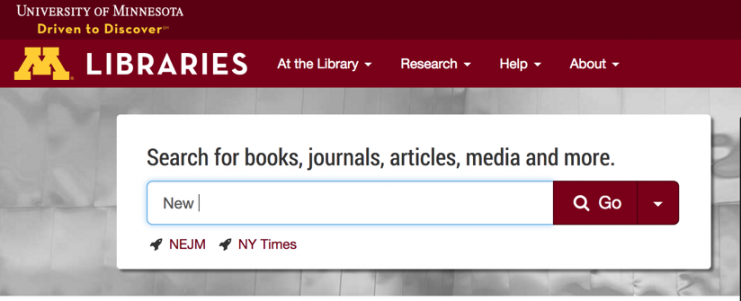By Jon Jeffryes
You have probably noticed a new feature when putting search terms into the University of Minnesota Libraries’ website search box. As you start to type the website automatically matches your terms and suggests links to some of our most used resources and services.
 Clicking on the link next to the rocket icon takes you directly to the listed resource. It bypasses a list of search results that you’d otherwise have to scan and evaluate to find the link you wanted.
Clicking on the link next to the rocket icon takes you directly to the listed resource. It bypasses a list of search results that you’d otherwise have to scan and evaluate to find the link you wanted.
Previously if you were looking for the New York Times you’d have to type in the whole title and then you’d get a result list that went on for multiple pages. It would include a link to the newspaper, but also to history books about the paper, journalism studies, and other links that you would have to go through to access the paper. Now after typing “new” the search suggestion feature offers “NY Times,” you click it and you’re on your way directly to the paper.
Search suggestion links were created for the most frequently searched of the Libraries’ most popular electronic resources and library services. The goal behind the addition was to save users time when searching for popular items. But even seemingly small additions necessitate a lot of thought and work.
Meeting the needs of all users
Any change to the Libraries’ website must take into consideration the needs of a wide spectrum of researchers.
“We always struggle when we’re building interfaces for the Libraries because we need to serve both veteran users very familiar with the way things work and successful and efficient with our systems the way they are.” explains Cody Hanson, Director of Web Development. “But we also need to serve people who are brand new to the university and to academic libraries and academic research.”
The streamlined service provided by search suggestions bridges the needs of both groups. It gets expert researchers to the information they needed more quickly and it reduces potential stumbling blocks for less experienced researchers.
Behind the scenes
The work of a library developer requires a wide range of skills. “It requires technical understanding necessary to build and style,” says Hanson, “but also an understanding of user experience.”
That means tracking the trends and developments across the internet. “Users are coming into our system with their experiences on the internet broadly,” Hanson explains.
Libraries developers Eric Larson and Amy Drayer have both led the project during different portions of its development. They focus on user experience and investigate the functionality of popular sites to learn what expectations researchers bring with them when they come to the Libraries’ website.
The first step in building the feature was determining which resources were the most heavily used and would benefit from a search suggestion link. Statistics on usage were cross analyzed with numbers of searches on the Libraries’ website. An initial list of 100 resources was produced reflecting the most searched and most heavily used items.
A project like this requires collaboration across all areas of the Libraries. Staff members who manage electronic subscriptions generated the statistics and then created stable links when the feature went into production. Reference desk staff and subject specialists consulted on their first-hand experience working with researchers.
Even the design of the rocket icon resulted from careful consideration. “We were trying to convey as concisely as possible, ‘This is not going to be a search.’” Hanson explains. “‘This is going to go directly to the resource.’”
Monitoring and improvements
The web development team continues to track the usage and seeks ways to improve its functionality. In the spring, the team increased the number of links that appear to around 150 resources. Along with databases and journals, links have also been created for library services and frequently visited Libraries’ webpages, like SMART Learning Commons, Interlibrary Loan, and Libraries’ Tutorials and Guides.
As the feature evolves the foundational goal remains the same: saving people time and making things simpler.




